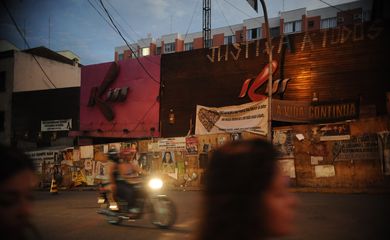Kiss Case: Testimonials Continue on Seventh Day of Jury

The audio operator of Banda Gurizada Fandangueira at the time of the fire at the Kiss Nightclub, Venâncio da Silva Anschau, 40 years old, was one of the people who gave testimony this Tuesday (7). The trial is already the longest in the history of the Judiciary Branch of Rio Grande do Sul, surpassing the jury in the case of the boy Bernardo, which took place in the District of Três Passos, in 2018, which lasted five days.

According to Anschau, the group had already performed at Nightclub Kiss making use of pyrotechnic artifacts. According to Anschau, on the night of the fire, the band took the stage at around 2:30 am and he was at the sound table when the fireworks, which were on the sides of the stage floor, were activated. Despite the proximity, he did not notice the moment when the fire started.
"Suddenly, the band stopped playing." The loudspeaker saw the members of the group with bottles of water.
The operator said he had muted the sound the moment he saw a person step onto the stage and later saw the person trying to use a fire extinguisher.
“Later, at the police station, I asked Marcelo [who had also tried to use the equipment] what happened; and he said he didn't know, that he beat him and nothing came out”.
The deponent clarified that the microphone was not made any announcement to the public of what was happening. “I didn't know what was going on. I was wrong to block the sound”, she said, crying.
On the way out, Venâncio told people nearby to leave the place and informed one of the security guards: “he's opening fire in the back”.
Anschau was admitted to the hospital for exposure to smoke, and said he never talked to anyone about the tragedy and even had medical treatment because of the pulmonary sequelae.
Another person heard on Tuesday was architect Nivia da Silva Braido. She was heard as an informant, having had a relationship in the past with a former lawyer from the Association of Families of Victims and Survivors of the Tragedy of Santa Maria.
In 2012, she was approached by one of the defendants, Elissandro Callegaro Spohr (Kiko) to put a wallpaper in one of the environments of the Kiss Nightclub and said that she asked who was the technical responsible for the works and warned about the risk of the absence of a technical manager.
“Any change in layout, renovation, even a residential project, a professional is needed to guarantee the safety of the work, both during and after the execution guarantee”, he said in a statement.
She also heard that Kiko was working the issue to solve the problem of acoustic leakage as required by the Public Ministry.
She also said that she was a regular at the club before the renovation and saw, on subsequent visits, that some of her suggestions were adopted at the nightclub, such as putting another exit door, but she did not observe whether there were emergency exits or fire extinguishers. fire.
The former Chief of Staff of the 4th Regional Command of Firefighters of Santa Maria Gerson da Rosa Pereira, listed by the defense of Elissandro Spohr, will still be heard today.
Nilvo José Dornelles, a witness appointed by Marcelo de Jesus dos Santos, will also be questioned today.
Yesterday (6), Márcio André de Jesus dos Santos, Stenio Rodrigues Fernandes, Willian Renato Machado and Nathália Daronch were heard.
Understand
The tragedy, which killed 242 people and left 636 injured, began on the stage, where the Banda Gurizada Fandangueira was performing, and soon spread, causing a lot of toxic smoke. One of the members fired a pyrotechnic device, hitting part of the building's roof, which caught fire.
The tragedy, which killed mainly young people, marked the city of Santa Maria and shook the entire country, due to the large number of deaths and the strong images. The club had only one unobstructed exit door. Firefighters and people tried, anyway, to open passages by breaking the walls of the house, but the delay in helping turned out to be tragic for the visitors.
Most ended up dying from inhaling toxic smoke from the sound insulation of the ceiling, formed by a flammable foam, incompatible with modern safety standards.
After the tragedy, rules for fire prevention in similar establishments were changed to ensure greater safety throughout Brazil.
Since the fire, the families of the young people who died have formed an association and every year, on January 27th, they remember the tragedy, the biggest in the state of Rio Grande do Sul and one of the biggest in Brazil.
* With information from TJRS
Text translated using artificial intelligence.




